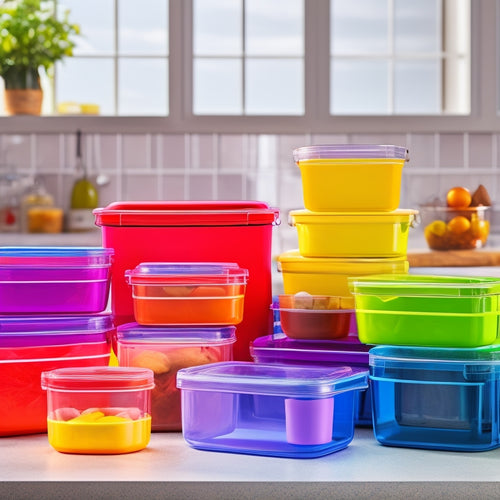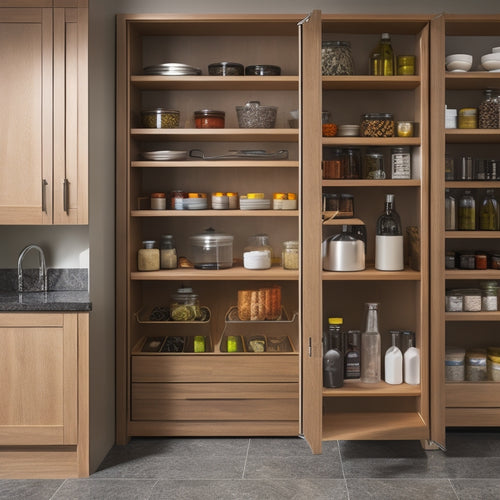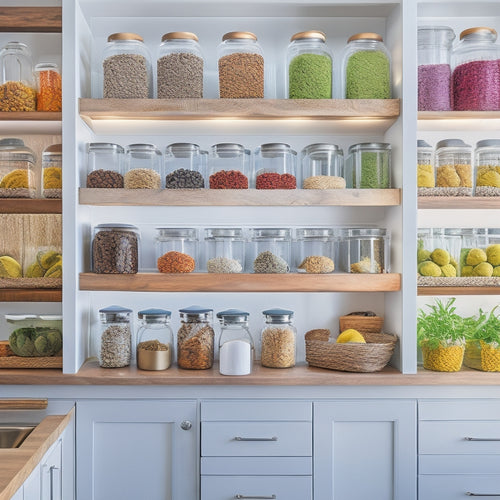
7 Essential Design Tips for Wheelchair-Friendly Kitchens
Share
When designing a wheelchair-friendly kitchen, you'll want to prioritize wide clearances, adjustable counter heights, and roll-under sinks for easy navigation and accessibility. Incorporate pull-out storage solutions, like shelves and carousels, to create easy reach zones. Don't forget to install slip-resistant flooring and open shelving tailored to user needs. Finally, combine ambient and task-focused lighting to guarantee clear visibility. By incorporating these essential design tips, you'll create a space that's both functional and enjoyable for everyone. Now, get ready to explore more ideas to create a kitchen that's tailored to meet the unique needs of its users.
Key Takeaways
• Ensure a minimum clearance of 42 inches between countertops, appliances, and walls for smooth wheelchair navigation.
• Incorporate adjustable counter heights to accommodate different users' needs and create easy reach zones.
• Install a roll-under sink with a single-handle faucet and shallow basin for easy access and reduced reach.
• Prioritize pull-out storage solutions with easy access shelves, dividers, and corner carousels for convenient organization.
• Choose slip-resistant flooring, such as textured vinyl or cork, to ensure safety and traction in the kitchen.
Wide Clearances for Easy Navigation
Create a wheelchair-friendly kitchen by ensuring a minimum clearance of 42 inches between countertops, appliances, and walls to allow for easy navigation and comfortable movement around the space. You'll want to pay special attention to corner spaces, where it's easy to get stuck or feel claustrophobic.
Consider installing a curved or angled countertop in these areas to create a smooth, flowing path. Islands can be particularly challenging, but opting for an L-shaped or U-shaped island can help to create more open space and allow for easier movement around the perimeter.
When planning your kitchen layout, think about the flow of traffic and how you can create a clear path for wheelchair users. Avoid placing appliances or cabinets in a way that creates narrow walkways or bottlenecks. Instead, focus on creating wide, open spaces that allow for easy navigation.
Adjustable Counter Heights Matter
When designing a wheelchair-friendly kitchen, you'll want to prioritize adjustable counter heights that cater to different users' needs.
By incorporating easy reach zones, varying counter heights, and smooth connection points, you'll create a space that's accessible and comfortable for everyone.
Easy Reach Zones
You'll appreciate the flexibility of adjustable counter heights, which allow you to set up easy reach zones that cater to your unique needs and preferences. These zones enable you to access essential items without straining or relying on others. By optimizing your kitchen's layout, you can create a more independent cooking experience.
Corner spaces, often considered dead zones, can be transformed into valuable storage areas with adjustable shelves or carousels. This allows you to store frequently used items, such as spices or oils, within easy reach. Hidden compartments can also be incorporated into your design, providing a convenient place to store appliances, cookbooks, or other kitchen essentials. By incorporating these features, you'll be able to navigate your kitchen with greater ease and confidence.
When designing your easy reach zones, consider the height and placement of your most frequently used items. This will make sure that everything you need is within comfortable reach, reducing the need for stretching or bending. By prioritizing accessibility and convenience, you'll create a kitchen that truly serves you.
Counter Height Variety
Opting for adjustable counter heights allows you to tailor your kitchen to your unique needs, guaranteeing that every station is set at the perfect level for comfortable, strain-free cooking and meal prep. This flexibility is especially important in wheelchair-friendly kitchens, where adaptability is key.
By installing counters with adjustable heights, you can cater to users of varying abilities and mobility levels.
When designing your kitchen, consider incorporating Universal Standards for counter heights, which typically range from 28 to 34 inches. However, don't be limited by these standards – Custom Options can be tailored to meet individual needs.
For instance, you can install counters with hydraulic or electric adjustment systems, allowing users to effortlessly change the height to suit their requirements. This adaptability ensures that everyone can participate in cooking and meal prep, regardless of their abilities.
Smooth Transition Points
As you move around your kitchen, adjustable counter heights become even more important at smooth handover points, where users with mobility impairments need to navigate from one task to another without obstacles.
Smooth handover points are vital to guarantee a seamless workflow, and it's paramount to take into account the flow of your kitchen design. For instance, when moving from the cooking area to the sink, a sudden change in counter height can be a significant barrier. By incorporating adjustable counter heights, you can create a more inclusive space that accommodates different abilities.
To further enhance smooth handover points, consider seamless flooring and threshold removal. A continuous floor surface allows wheelchair users to move easily around the kitchen, while the removal of thresholds eliminates tripping hazards.
Roll-Under Sink Accessibility
When designing a wheelchair-friendly kitchen, take into account installing a roll-under sink that allows you to easily slide your chair underneath, creating a comfortable and accessible workspace. This design feature is vital for individuals with mobility impairments, as it enables them to easily access the sink without obstacles.
To guarantee maximum accessibility, opt for single-handle faucets, which are easier to operate than two-handle models. This will allow users to effortlessly control water temperature and flow with one hand.
Mounting options are also important to take into account. Wall-mounted sinks provide more clearance underneath, allowing for a more comfortable and accessible experience. Additionally, consider installing a sink with a shallow basin, as this will reduce the reach required to wash hands or dishes.
Pull-Out Storage for Convenience
When designing a wheelchair-friendly kitchen, you'll want to prioritize pull-out storage solutions that cater to your needs.
By incorporating easy access shelves, you'll be able to effortlessly retrieve items without straining or struggling.
Choose shelves at a suitable height that allows you to comfortably reach them from your seated position.
Easy Access Shelves
How can you guarantee that your kitchen shelves are easily accessible from your wheelchair, allowing you to grab what you need without straining or relying on others? One effective way is to incorporate easy access shelves into your kitchen design. These shelves should be installed at a comfortable height, allowing you to reach items without straining or stretching.
You can also consider installing shelf dividers to separate items and prevent clutter, making it easier to find what you need. Additionally, consider corner carousels, which can be rotated to bring items to you, eliminating the need to reach or stretch.
Another key aspect is to make sure that your shelves are wide enough to accommodate your wheelchair, allowing you to easily roll up and access the items you need. By incorporating these design elements, you can create a kitchen that isn't only functional but also comfortable and convenient for you.
With easy access shelves, you'll be able to cook, prepare meals, and live independently, without relying on others.
Optimal Shelf Height
Installing shelves at a convenient height, typically between 28 and 34 inches from the floor, allows you to easily retrieve items without straining or relying on others. This ideal shelf height is especially important for individuals with mobility impairments, as it enables them to access essential items independently.
As our aging population continues to grow, incorporating ergonomic standards into kitchen design becomes increasingly crucial. By placing frequently used items within easy reach, you can reduce the risk of injury and promote independence.
For wheelchair users, shelves at this height can be easily accessed from a seated position, eliminating the need for awkward reaching or straining. Additionally, consider incorporating pull-out storage solutions to further enhance convenience and accessibility.
Slip-Resistant Flooring Is Key
You'll want to prioritize slip-resistant flooring in your kitchen design, as it's essential for preventing accidents and ensuring safe mobility for wheelchair users.
A wheelchair-friendly kitchen should feature flooring that provides traction, even when wet. When selecting a floor material, take into account options like textured vinyl, rubber, or cork, which offer better grip than smooth surfaces like tile or hardwood. Avoid polished or glossy finishes, as they can be hazardous.
When it comes to installation methods, make sure that the flooring is securely fastened to prevent it from shifting or buckling under the weight of a wheelchair. You may also want to contemplate installing flooring with a slight texture or pattern to provide additional traction.
Additionally, ensure the flooring is easy to clean and maintain, as this will help prevent slippery substances from accumulating on the surface. By choosing the right floor material and installation methods, you can create a safe and accessible kitchen environment for wheelchair users.
Open Shelving for Easy Access
By incorporating open shelving into your kitchen design, you can create an accessible storage system that allows wheelchair users to easily retrieve items without having to navigate narrow aisles or struggle with hard-to-reach cabinets. This design element not only promotes independence but also adds a touch of elegance to your kitchen.
When it comes to open shelving, you have numerous aesthetic options to choose from, allowing you to infuse your personal style into the design. Consider the following benefits:
-
Easy-to-reach storage: Place frequently used items on lower shelves, making them easily accessible for wheelchair users.
-
Customizable layout: Design the shelving to fit the user's needs, such as installing shelves at a comfortable height or adding pull-out baskets for easy access.
-
Visual appeal: Open shelving can add a sense of openness and airiness to the kitchen, creating a welcoming atmosphere for everyone.
Smart Lighting for Clear Visibility
Clear visibility is crucial in a wheelchair-friendly kitchen, and smart lighting can make all the difference in guaranteeing a safe and independent cooking experience. You'll want to create a lighting plan that combines ambient glows with task-focused lighting to achieve the best visibility.
Ambient glows, such as recessed lighting or under-cabinet lighting, provide overall illumination, reducing eye strain and creating a welcoming atmosphere. Task-focused lighting, like pendant lights or under-counter lights, targets specific areas, like countertops or sink basins, where you'll be performing tasks. This combination enables you to navigate the kitchen with confidence, even in areas with limited mobility.
When selecting lighting fixtures, consider using LED lights, which are energy-efficient and produce minimal heat. You should also install light switches at accessible heights, around 36-40 inches from the floor, to ensure easy operation. Don't forget to add dimmers or smart lighting controls to adjust the brightness levels according to your needs.
Frequently Asked Questions
Can a Wheelchair-Friendly Kitchen Be Stylish and Modern?
You can absolutely create a stylish and modern wheelchair-friendly kitchen that exudes aesthetic balance and universal chic, blending functionality with sleek design elements, clever storage, and thoughtful layout to create a beautiful, inclusive space.
Are There Any Wheelchair-Friendly Kitchen Design Certifications?
"Imagine ancient Greeks designing inclusive spaces! You'll be thrilled to know that yes, certifications exist. Look for designers who've completed the Certification Process, ensuring Regulatory Compliance, to create kitchens that are both stylish and accessible."
How Much Does a Wheelchair-Friendly Kitchen Renovation Cost?
You're likely wondering how much a wheelchair-friendly kitchen renovation will set you back; expect to spend between $10,000 to $50,000, but be prepared for budget constraints and potential cost overruns, especially if you're making significant changes.
Can I DIY a Wheelchair-Friendly Kitchen Renovation Project?
'Oh, you want to DIY a wheelchair-friendly kitchen renovation? Ha! Good luck with that. Seriously, don't risk it. You'll need to navigate permit requirements and professional guidance to guarantee accessibility and safety - leave it to the experts.'
Are Wheelchair-Friendly Kitchen Designs Only for Wheelchair Users?
You might think wheelchair-friendly kitchen designs are only for wheelchair users, but they actually promote universal accessibility and inclusive living, benefiting everyone, regardless of age or ability, with safer, more convenient spaces.
Related Posts
-

Stackable Kitchen Containers for Modular Systems
Stackable kitchen containers for modular systems change your cooking space by maximizing vertical storage and enhanci...
-

Space-Saving Lazy Susan Cabinet Solutions
Space-saving Lazy Susan cabinet solutions can change those awkward corner spaces into organized storage wonders. You'...
-

Innovative Lazy Susan Storage Solutions
Innovative Lazy Susan storage solutions are a revolutionary advancement for any space, especially in kitchens. They m...


